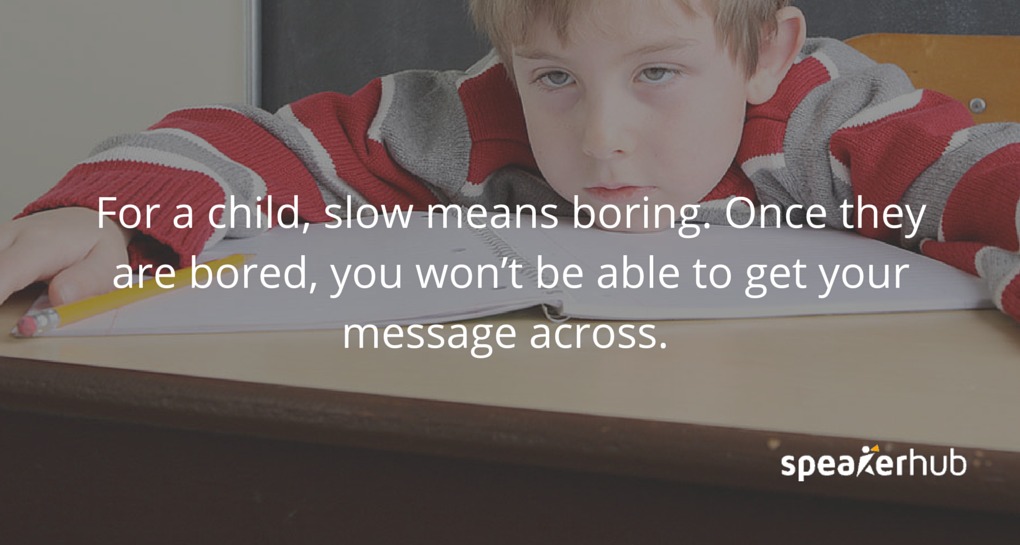Creating engaging presentations for children: Why you can't treat them like mini-adults

5 to 10 year-olds might be the toughest audience that you as a presenter will ever face.
If you cannot connect with and engage them, it won’t be long before they start looking away, fidgeting, and flopping on the floor (or on the child next to them.)
The best ways to engage children is to get into their mindset, keep things simple and visual, and use a lot of interactivity.
Start by asking their teacher (or mentor) what they will expect from your presentation. Find out how much they already know about the topic, and roughly how long your presentation should be. They will know their particular group, and take out a lot of the guess work. Pay close attention to their advice and work it into your presentation.
Below are some tips on how to adapt your presentation to connect and engage younger audience.
 How to connect with children
How to connect with children

Be empathetic. Start by putting yourself into their (little) shoes. Try to empathize with their mindset, and then decide what will be the most important thing for them to get out of your talk will be.
Don’t try to be one of them, this very seldomly works with children. Instead, project yourself as the type of adult they may want to become.
Young people are genuine in their feedback: when they don’t like what’s being said, they will let you know. They are not naturally rude: they just haven’t learned how to pretend yet.

Avoid being too perfect or scripted, they will quickly find this boring or disingenuous. If you want to connect with them, tell them what you did, thought, felt, or found, what you felt as opposed to abstract concepts.
Make your presentation as relevant as possible, anchor it to a topic they just learned about, or an everyday example that they can immediately relate to.
Do your best to get an emotional response out from your audience right away. If you want them to listen to you, you will need to connect with them on a more personal level right away, and stop them from feeling indifferent.
In your introduction, make your topic relevant to them, by using examples of things that they can relate to.
Get to the point quickly, then keep up the pace.
Keep your presentation short and sweet.
The average attention span of 3 to 6 year old is under 10 minutes; for 7 to 12 year olds you have about 20 minutes; and a maximum of 40 minutes the 12 to 17 year range. In short, the younger they are the less time you will have to get your idea across.

You need to quickly get to the point and move on.
Often when we are presenting to adults, we make sure to evenly pace our information, with long, meaningful pauses and a measured, moderate pace. This, however, does not work well with a young audience.
For children, slow means boring and once they are bored, you’ve lost them and you won’t be able to get your message across.
Try the one-sentence rule: say the main point of your talk in the opening sentence.
If you ramble or talk too much, children will get the feeling that you’re not quite sure what it is you want to say, and they will lose interest in waiting for you to figure it out.

Keep your language simple
Although you want to keep things moving at a quicker pace: this does not mean that you should talk faster.
Adults can speak and understand roughly 150 words per minute, but studies have shown that younger children can only process about 124 words per minute. This means you are going to have to speak a bit more slowly and carefully.

When talking to younger children, use short simple sentences with one-syllable words.
Ask the teacher or leader for advice on how complex their language is, or listen to how they communicate with each other and adapt to match their complexity.
Watch your words and phrases and be very intentional with the language you use; use conversational language rather than formal.
Avoid using “baby talk” or patronizing your audience, but at the same time, use a kind of language that children will actually understand and be able to relate to.
Here are some examples:
- “I like the outdoors” can be made more relatable by saying “I love jumping in puddles and building campfires” instead.
- “€1 billion euros” can change to “enough money to fill this room from floor to ceiling”
- “Our study looked for explanations” might be too complex, try using “we searched for answers to our questions”

Get very visual
The younger the audience is, the more important your visuals will need to be.
Young children are primarily visual creatures. Standing in one place and just talking at them will be painfully boring for most children.
You have a maximum of a few minutes of talking without doing anything, or showing them some sort of visual: go over this and you will lose them.
Children are very concrete thinkers and when they can see concrete examples, it will help them understand what you are saying. Bring with you lots of pictures and props, even your tools and uniform can help.
As much as possible, use your body to demonstrate physical actions, because the visuals will help draw the audience into your story.
If you are using a slide presentation, be more colourful than professional. Use comics, well-known cartoon characters, and feel free to animate your slides, this will add a level of excitement to the presentation.

Use movement, interaction and involvement
Although adults find it fairly straightforward to sit calmly and listen for 20 minutes, children crave interaction and movement.
You need to come up with ways to keep your audience stimulated and entertained.
Ask for a volunteer to demonstrate an action, hold a visual or prop, pass around handouts, or even to turn off the lights.
Ask the group to repeat key terms, or play a version of “when I say [fill in the blank], you say [fill in the blank].” You can even invite young children to stand up and pretend to make a motion, like climbing, cooking, or dancing, right along with you. Just make sure that it is age appropriate (ie. preteens will appreciate this a lot less than five year olds.)
From a simple show of hands, to a game, getting them up and moving around as part of your presentation will make it easier for them to connect with your message.
Always make sure the activity ties into your message, or the children will simply get sidetracked.
What to do if they get bored
If your audience is getting bored, wrap up your point, or shift gears quickly.
You will know when they are getting bored, because they will stop making eye contact with you, start wriggling, fidgeting or sighing, or will just have a glazed, unentertained look on their little faces.
When this happens move on to something else very quickly.
Don’t get flustered by spontaneous, excited behavior like talking, blurting things out or moving around a lot: this is completely normal and does not mean they are not engaging with you. Just work with it or move on.
Lastly, if ever you feel that things are getting out of control or you have lost them completely, ask for some help from the teacher or the group leader, and they can help bring the group back on track.

One of the main goals of SpeakerHub is to connect talented experts with the schools and organizations in their area.
You can make a positive impact in your community by communicating your message to local kids. If you’d like to learn more about being a volunteer speaker, please click here.
What are your best tips for working with younger audiences? We’d love to hear your stories. Contact us here.






